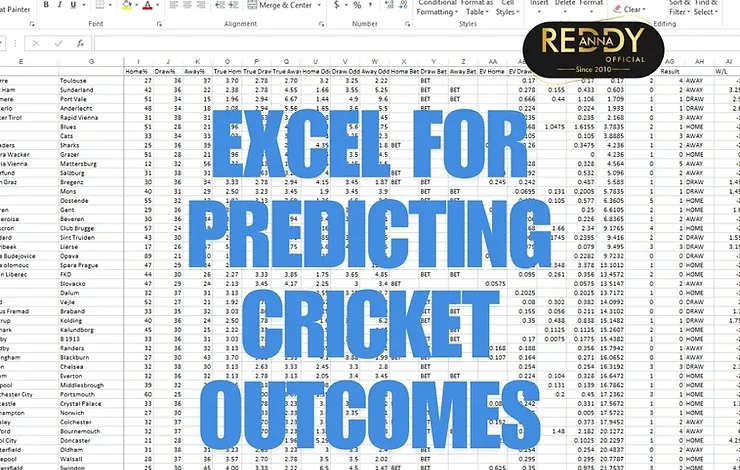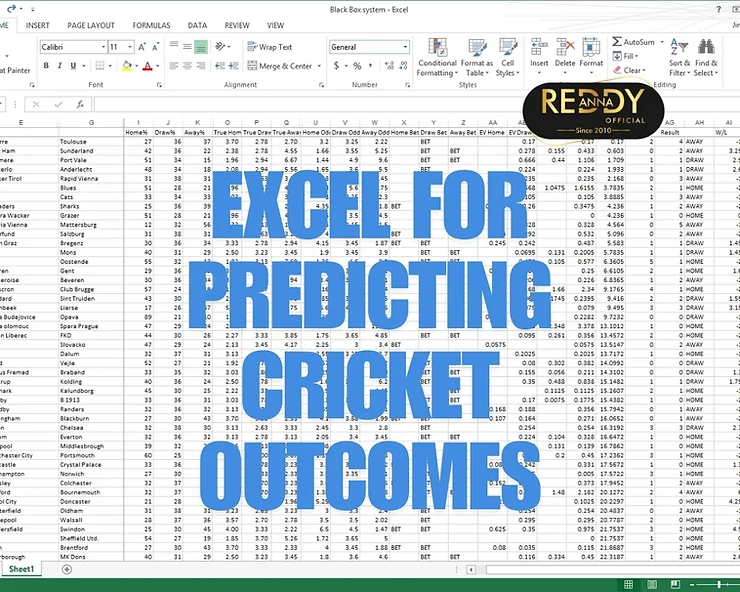R Programming/Excel with Advanced Functions: Predicting Cricket Outcomes and Market Inefficiencies

The rise of data analytics in cricket has transformed how matches are analyzed, and one of the most powerful tools behind this transformation is R programming and Excel with advanced functions. These tools allow for in-depth statistical analysis and predictive modeling, helping both teams and bettors to gain insights into match outcomes, player performances, and market inefficiencies. For those invested in sports betting, particularly cricket betting on platforms like Reddy Anna Sports ID, mastering these tools can offer a competitive edge.

In this article, we’ll dive deep into how R programming and Excel’s advanced functions are used to predict cricket match outcomes, player performances, and uncover market inefficiencies, along with practical examples, case studies, and insights. By the end, you’ll have a better understanding of how to leverage these powerful tools for cricket analysis and betting strategies.
1. Introduction to R Programming and Excel for Sports Analytics
Both R and Excel are widely used in the field of sports analytics, particularly cricket. They are designed to handle large datasets, perform complex mathematical calculations, and create predictive models.
- R Programming: Known for its statistical computing power, R can handle big data, build advanced predictive models, and visualize data trends. It’s popular among data scientists and statisticians.
- Excel: Excel may seem simple, but when combined with advanced functions like VLOOKUP, INDEX MATCH, SUMIFS, and PivotTables, it becomes a powerful tool for data analysis and visualization. Excel’s popularity stems from its accessibility and ease of use.
2. Key Concepts in Predictive Modeling for Cricket
Predictive modeling involves using historical data to predict future outcomes. In cricket, this means analyzing player statistics, pitch conditions, weather, and historical match data to predict:
- Match Outcomes: Will Team A win or lose?
- Player Performance: Will Player X score more than 50 runs?
- Market Inefficiencies: Are the betting odds undervaluing Team A’s chances of winning?
To build these models, advanced statistical techniques like linear regression, logistic regression, time-series analysis, and machine learning are used. Here’s how these can be applied to cricket:
| Predictive Task | Statistical Method | Explanation |
| Match Outcome Prediction | Logistic Regression | Predicts the probability of a binary outcome (win or lose). |
| Player Performance | Linear Regression | Predicts a continuous variable (e.g., runs scored by a player). |
| Market Inefficiencies | Time-Series Analysis | Detects patterns in betting odds over time to find inefficiencies. |
3. Using R Programming to Predict Cricket Match Outcomes
R programming offers a wide range of libraries and tools that can help predict cricket outcomes. Some of the popular R packages include:
- dplyr: For data manipulation.
- ggplot2: For data visualization.
- caret: For machine learning and model building.
- rvest: For web scraping data from cricket statistics websites.
Step-by-Step Example of Cricket Outcome Prediction Using R
Here’s an example of how you can use R programming to predict cricket match outcomes:
- Data Collection: Use web scraping to collect historical match data, player statistics, and conditions.
library(rvest) url <- ‘https://www.examplecricketstats.com‘ cricket_data <- url %>% read_html() %>% html_table(fill = TRUE) - Data Preprocessing: Clean the data and create new variables such as home advantage, form, and player fitness.
library(dplyr) cleaned_data <- cricket_data %>% filter(!is.na(Result)) %>% mutate(home_advantage = ifelse(HomeTeam == “Team A”, 1, 0)) - Building the Predictive Model: Use logistic regression to predict match outcomes.
model <- glm(Result ~ home_advantage + batting_average + bowling_average, data = cleaned_data, family = binomial) summary(model) - Model Evaluation: Use cross-validation to assess the accuracy of the model.
library(caret) train_control <- trainControl(method = “cv”, number = 10) model_cv <- train(Result ~ home_advantage + batting_average + bowling_average, data = cleaned_data, method = “glm”, family = “binomial”, trControl = train_control) print(model_cv)
4. Using Excel with Advanced Functions to Analyze Cricket Data
While R is great for complex analysis, Excel can be an equally powerful tool for cricket data analysis, especially for users who are less familiar with programming. Here’s how you can use Excel for advanced cricket analysis:
Key Excel Functions for Cricket Analysis
- VLOOKUP: Used to pull data from large datasets.
- INDEX MATCH: More flexible than VLOOKUP, allowing for complex data retrieval.
- SUMIFS: Summing values based on multiple conditions.
- PivotTables: To quickly summarize and analyze large datasets.
Excel Cricket Data Analysis Example
Here’s how Excel’s advanced functions can be used to analyze cricket performance and predict outcomes:
- Importing Historical Data: Import historical match data into Excel.
- Use pivot tables to summarize the performance of each team.
- Using SUMIFS to Calculate Averages: Calculate a player’s batting or bowling average.excel
=SUMIFS(Runs, Player, “Player Name”)/SUMIFS(Innings, Player, “Player Name”) - Creating a Dashboard: Use Excel charts and conditional formatting to visualize trends, like player form or team performance.
Case Study: Predicting Player Performance Using Excel
Let’s take the example of predicting Player X’s batting performance in the next match:
| Player Name | Matches | Runs | Average | Home Advantage |
| Player X | 20 | 1200 | 60 | Yes |
| Player Y | 25 | 950 | 38 | No |
Using SUMIFS and PivotTables, you can calculate Player X’s average at home and away matches. Based on this analysis, you may conclude that Player X performs better at home and predict a higher probability of a good performance in the upcoming match.
5. Case Study: Predicting Market Inefficiencies in Cricket Betting
Market inefficiencies arise when the betting odds don’t accurately reflect the actual probabilities of an event. R programming and Excel can help detect these inefficiencies by analyzing patterns in betting markets.
R Programming for Market Analysis
Here’s how R can be used to identify market inefficiencies:
- Collect Betting Odds Data: Use web scraping to collect historical betting odds.
- Analyze Odds Movement: Use time-series analysis to track how odds change leading up to a match.
- Identify Inefficiencies: Compare the actual outcomes with the odds to see if there’s a consistent undervaluing of certain teams.
Excel for Betting Odds Analysis
In Excel, you can track and analyze betting odds by using SUMIFS and conditional formatting to highlight inefficiencies.
| Match | Team A Odds | Team B Odds | Actual Outcome | Market Inefficiency |
| Match 1 | 2.5 | 1.6 | Team A wins | Team A undervalued |
| Match 2 | 1.8 | 2.1 | Team B wins | Team B undervalued |
6. Applications of R Programming and Excel in Cricket Betting
Both R programming and Excel have practical applications in cricket betting. Here are a few ways they can be applied:
1. Bet Tracking
Use Excel to track your betting history, calculate profit/loss, and analyze performance. Advanced Excel users can create automated dashboards that provide real-time updates on betting performance.
2. Predicting Player Performances
R programming can help you predict which players are likely to perform well in upcoming matches based on historical data. By analyzing past performance, pitch conditions, and opposition strength, bettors can make more informed decisions.
3. Simulating Matches
R allows you to simulate cricket matches by using Monte Carlo simulations, a technique that models the probability of different outcomes. This can give bettors a statistical edge by providing a deeper understanding of potential match results.
7. Conclusion: The Future of Cricket Betting and Data Analytics
The fusion of R programming and Excel with advanced functions has transformed how cricket is analyzed and, by extension, how people approach cricket betting. Whether it’s predicting match outcomes, analyzing player performance, or identifying market inefficiencies, these tools provide bettors with an unmatched edge.
For anyone involved in sports betting, especially on platforms like Reddy Anna Sports ID, understanding and mastering these tools is essential. By incorporating data-driven insights into your betting strategy, you can make more informed decisions, improve your long-term success rate, and enjoy a more rewarding betting experience.
For more details, visit:




